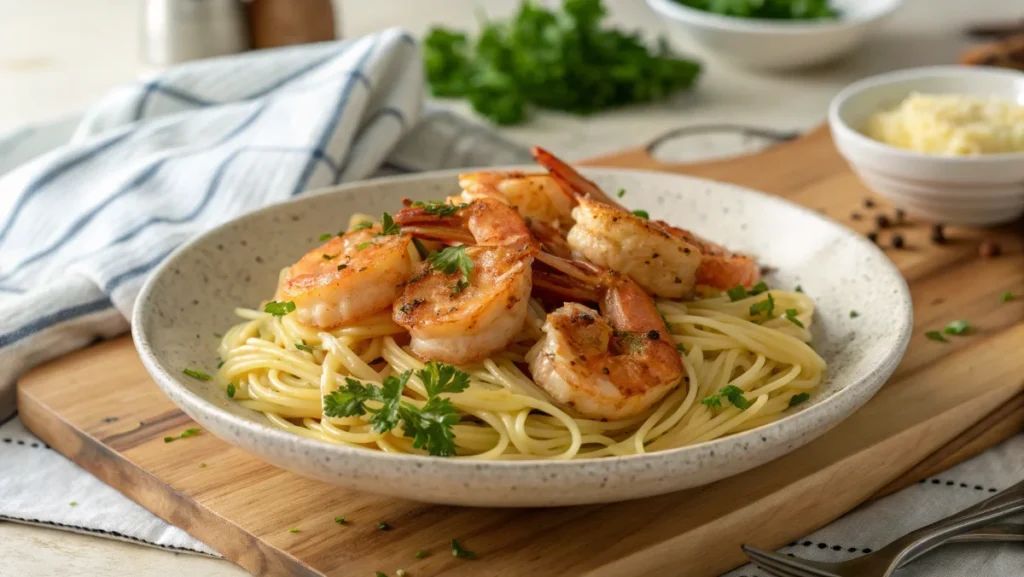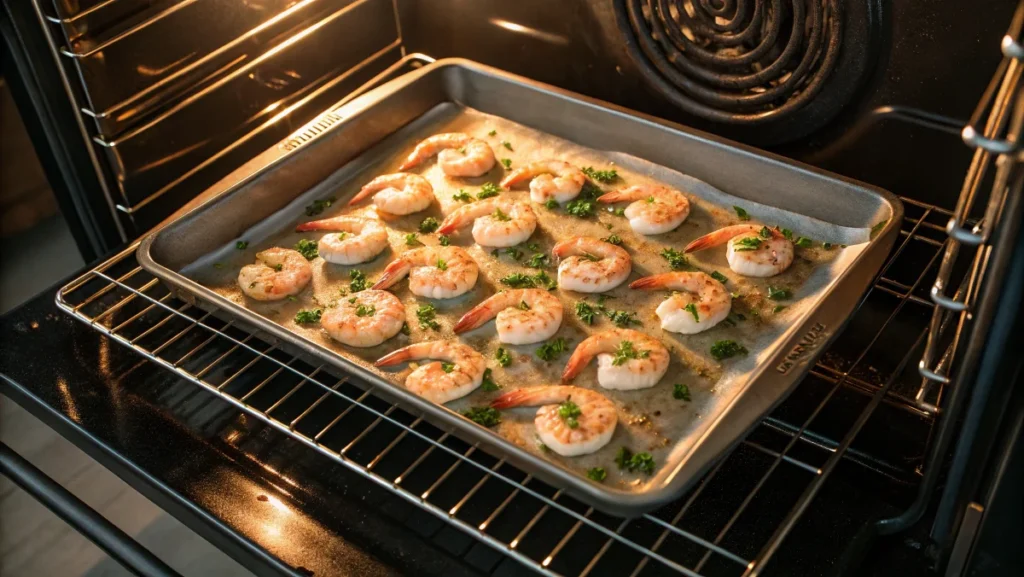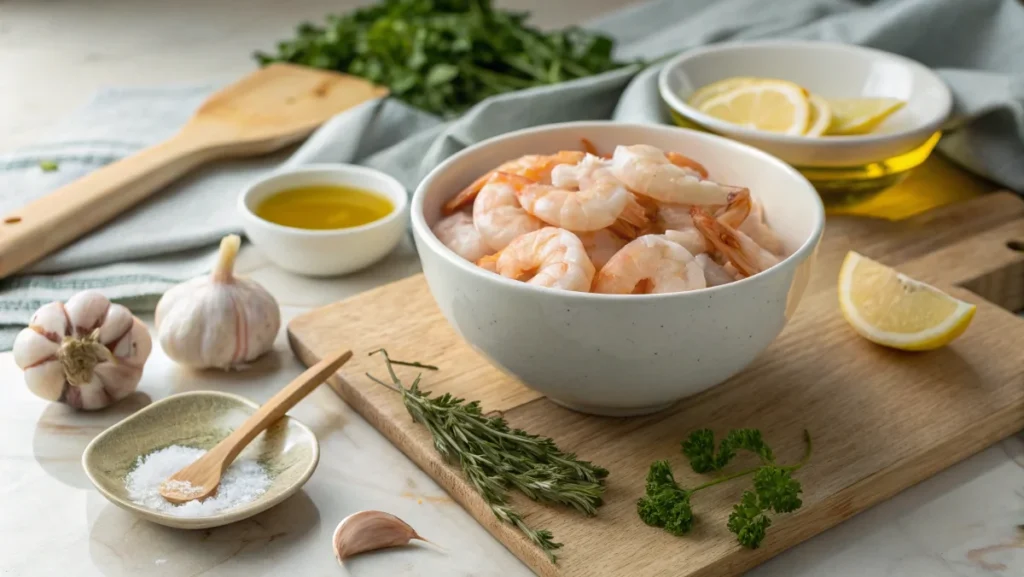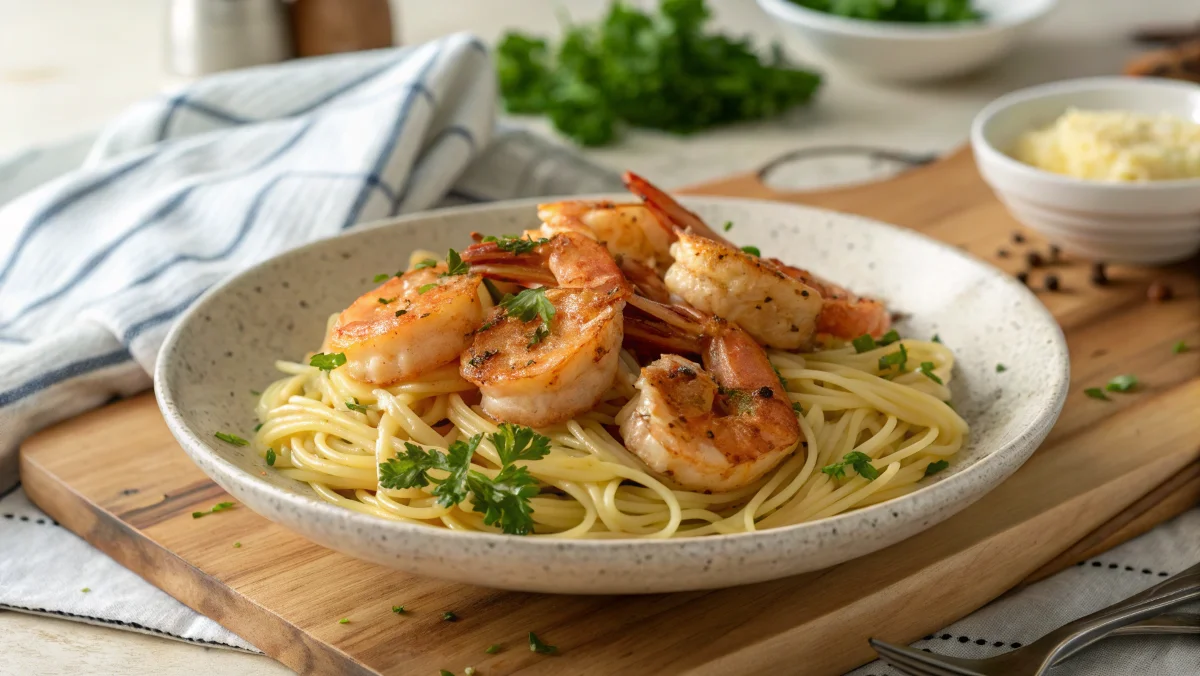Shrimp is one of the most versatile and flavorful seafood options available. Whether you’re preparing a quick weeknight dinner or a festive meal, baking shrimp can be an easy and delicious choice. However, knowing how long to bake shrimp at 400 degrees Fahrenheit is crucial to ensure it turns out perfectly cooked—neither underdone nor overdone. If you’ve ever wondered how long to bake shrimp to achieve that juicy, tender texture, you’re not alone. In this guide, we’ll cover everything you need to know about baking shrimp, including ideal baking times, preparation tips, and common mistakes to avoid.
Baked shrimp are tender, juicy, and full of flavor when prepared correctly. Several factors influence the baking time, including the shrimp’s size, whether it’s raw or pre-cooked, and its thickness. We’ll also explore various seasoning ideas, pairing options, and tips to elevate your shrimp baking experience.
For more insights on seafood cooking temperatures, you might find this article helpful:
Is Salmon Safe at 125°F? Cooking and Food Safety Guide

Table of Contents
How Long to Bake Shrimp at 400 Degrees Fahrenheit?
When baking shrimp at 400°F, the ideal cooking time typically ranges from 8 to 12 minutes, depending on the size of the shrimp and whether they are raw or pre-cooked. Shrimp cook quickly, so it’s important to keep an eye on them to avoid overcooking.
For raw shrimp:
- Smaller shrimp (51-60 count per pound): Bake for approximately 8 minutes.
- Medium shrimp (41-50 count per pound): Bake for about 9 minutes.
- Larger shrimp (21-30 count per pound): Bake for around 10-12 minutes.
If you are using pre-cooked shrimp, the baking time will be much shorter, usually around 5-7 minutes, as you’re essentially reheating them.
Always remember that the key to perfectly baked shrimp is monitoring their internal temperature. When wondering how long to bake shrimp, it’s important to focus on both time and temperature. Shrimp should reach an internal temperature of 120°F to 130°F to be fully cooked. Once they turn pink and opaque, you’ll have the perfect answer to how long to bake shrimp—you know they’re done.

Factors That Affect Shrimp Baking Time
Several factors can influence how long to bake shrimp at 400 degrees Fahrenheit. These include the shrimp’s size, whether it’s frozen or fresh, and how much you’re baking at once. Below are some critical factors to consider:
- Shrimp Size: Larger shrimp require more time to bake, while smaller ones cook faster. Always adjust your baking time according to the size of the shrimp.
- Frozen or Fresh Shrimp: If you’re using frozen shrimp, they will need extra time to bake compared to fresh shrimp. It’s also crucial to thaw frozen shrimp before baking to ensure even cooking.
- Oven Variations: Not all ovens heat evenly. So, you may need to adjust the cooking time based on how your oven performs.
- Baking Tray or Pan: A thinner baking tray will allow heat to distribute more evenly, while a thicker pan might slow down the cooking process.
Understanding these factors will help you cook shrimp to perfection every time.
Preparing Shrimp for Baking
Before baking shrimp at 400°F, proper preparation is essential to ensure the best flavor and texture. Here’s how to prepare shrimp for baking:
- Peel and Devein the Shrimp: If you’re using raw shrimp, start by peeling off the shells and deveining them. This will ensure a cleaner and more enjoyable eating experience.
- Rinse and Dry: Rinse the shrimp under cold water to remove any debris, then pat them dry with a paper towel. This will help them bake more evenly.
- Seasoning: Season the shrimp with your favorite spices and marinades. Consider using a mixture of olive oil, garlic, lemon juice, salt, and pepper for a classic flavor. Alternatively, you can use a premade seafood seasoning.
- Skewering (Optional): If you’re cooking larger shrimp, consider skewering them to help them cook evenly and prevent curling during baking.
Once the shrimp are prepped, it’s time to move on to the next step: baking them at the ideal temperature.

Ideal Baking Time for Raw Shrimp
When baking raw shrimp at 400°F, the cooking time is quite short—typically between 8 to 12 minutes, depending on the size. Here’s a breakdown for better clarity:
- Small Shrimp (51-60 count per pound): Bake for 8-9 minutes. These shrimp cook quickly due to their small size.
- Medium Shrimp (41-50 count per pound): Bake for 9-10 minutes.
- Large Shrimp (21-30 count per pound): Bake for 10-12 minutes. These shrimp require more time to ensure they cook through.
For best results, always check the shrimp’s appearance and texture: they should be opaque and pink. Understanding how long to bake shrimp helps you avoid common mistakes. Undercooked shrimp can be unsafe, while overcooked shrimp can become rubbery, so be sure to monitor them closely to get the timing just right.
Baking Time for Pre-Cooked Shrimp
Pre-cooked shrimp only require reheating, as they’ve already been cooked during processing. Baking pre-cooked shrimp at 400°F is a quick process, usually taking only about 5 to 7 minutes. The goal is to warm the shrimp through without overcooking them.
To reheat pre-cooked shrimp:
- Preheat your oven to 400°F.
- Arrange the shrimp in a single layer on a baking sheet.
- Bake for 5-7 minutes, or until heated through.
Keep in mind that if you overcook pre-cooked shrimp, they can become tough and dry. Therefore, it’s crucial to monitor the shrimp during the reheating process carefully.
Should You Cover Shrimp While Baking?
When considering how long to bake shrimp at 400°F, covering them is generally not recommended. While covering shrimp might help retain moisture, it can also prevent them from achieving a desirable crispy texture. Shrimp bake quickly, and since they don’t require long cooking times, exposing them to the oven’s heat ensures a nice, caramelized exterior.
However, there are situations where you might consider covering shrimp:
- Moisture Retention: If you’re baking shrimp in a marinade or if the shrimp are extremely lean, you might want to cover them to avoid drying out the meat.
- Preventing Overcooking: If you’re baking a large batch of shrimp and you’re worried about uneven cooking, covering them with foil can help maintain consistent heat distribution.
Generally, for most recipes, baking shrimp uncovered will yield the best results in terms of texture and flavor.
How to Tell If Shrimp Is Fully Cooked
The most reliable indicators that shrimp are fully cooked include visual and textural clues. Here’s how to tell:
- Color: Raw shrimp typically start off gray, but once fully cooked, they turn a vibrant pink or reddish color.
- Shape: Cooked shrimp curl into a tight “C” shape. If the shrimp is still in a loose “U” shape, it likely needs more time.
- Opaque Flesh: When cooked, shrimp flesh turns opaque, losing its translucent appearance.
- Internal Temperature: The safest method to check shrimp doneness is to measure their internal temperature. Fully cooked shrimp should reach an internal temperature of 120°F to 130°F.
If the shrimp meet these criteria, they are safe to eat. Avoid overcooking, as shrimp can become tough and rubbery.
Tips for Evenly Baking Shrimp at 400°F
To ensure your shrimp bake evenly at 400°F, follow these tips:
- Spread Shrimp Evenly: Arrange the shrimp in a single layer on the baking sheet. Overcrowding can lead to uneven cooking and steam instead of baking.
- Use a Cooling Rack: For even cooking, consider placing a cooling rack over the baking sheet. This allows air to circulate around the shrimp, ensuring they cook evenly on all sides.
- Preheat Your Oven: Always preheat the oven to 400°F before placing the shrimp inside. This ensures the shrimp begin cooking as soon as they hit the hot oven.
- Check Halfway Through: For large shrimp, turn them over halfway through the baking time to ensure even cooking and browning.
By following these steps, you can ensure your shrimp cook perfectly every time.
Using Frozen Shrimp: Adjusting Baking Time
When baking frozen shrimp at 400°F, you will need to adjust the cooking time slightly. Here’s how:
- Do Not Thaw: While it’s best to thaw shrimp for even cooking, you can bake them straight from frozen. Just keep in mind that frozen shrimp will need about 2-3 extra minutes of baking time.
- Increase Cooking Time: Frozen shrimp require roughly 10-15 minutes, depending on size and thickness.
- Avoid Overcrowding: Even when baking frozen shrimp, ensure they are spread out in a single layer to allow for proper heat circulation.
With these adjustments, you can still achieve great results with frozen shrimp.
Common Mistakes When Baking Shrimp
Baking shrimp seems straightforward, but a few common mistakes can ruin your dish. Here are some pitfalls to avoid:
- Overbaking Shrimp: Shrimp cook very quickly, and overbaking can lead to tough, rubbery seafood. Always check them early to avoid this.
- Using Frozen Shrimp Without Thawing: Thaw shrimp before baking to ensure they cook evenly.
- Underseasoning: Shrimp have a delicate flavor that can easily be overwhelmed. Be sure to season them generously, but don’t go overboard.
- Crowding the Baking Sheet: When shrimp are too close together, they may steam instead of bake. Always spread them in a single layer.
By avoiding these mistakes, you can bake shrimp perfectly every time.
Recommended Seasonings for Baked Shrimp
When it comes to seasoning baked shrimp, the possibilities are endless. Here are a few delicious ideas to consider:
- Garlic and Lemon: A classic combination that brings out the natural sweetness of shrimp.
- Old Bay Seasoning: A favorite for seafood, it adds a zesty kick to your shrimp.
- Cajun Spice: For those who like heat, Cajun seasoning brings bold flavors to shrimp.
- Herb Butter: A simple mixture of melted butter, garlic, and fresh herbs will create a rich and flavorful coating.
- Paprika and Chili Powder: For a smoky and slightly spicy flavor, try paprika combined with a bit of chili powder.
Season shrimp before baking and allow the flavors to meld together for an unforgettable taste.
Pairing Baked Shrimp with Side Dishes
Baked shrimp pairs well with a variety of side dishes. Consider these options:
- Garlic Butter Pasta: A creamy, comforting side that complements the shrimp.
- Roasted Vegetables: Roasted asparagus, zucchini, or bell peppers provide a healthy, flavorful contrast.
- Rice Pilaf: A fragrant rice dish adds texture and a complementary flavor to baked shrimp.
- Caesar Salad: A crisp, tangy salad balances the richness of the shrimp.
These sides will elevate your baked shrimp into a full meal that’s sure to impress.
FAQs:
How Long Should You Cook Shrimp in the Oven at 400 Degrees?
When baking shrimp in the oven at 400°F, the ideal cooking time depends on the size of the shrimp. Generally, you should bake shrimp for 8 to 12 minutes. Smaller shrimp (like those 51-60 count per pound) will cook faster, while larger shrimp (like those 21-30 count per pound) may take closer to 12 minutes. The key is to check for visual cues such as pink and opaque shrimp, and the flesh should be firm. Always avoid overcooking to prevent the shrimp from becoming rubbery.
What is the Best Temperature for Shrimp in the Oven?
When determining how long to bake shrimp, the best temperature for baking them in the oven is 400°F. This high temperature allows the shrimp to cook quickly and evenly, achieving a tender and juicy texture. At 400°F, how long to bake shrimp typically ranges from 8 to 12 minutes, depending on their size. This temperature is hot enough to produce a nice caramelized exterior while keeping the shrimp moist on the inside.
Do You Have to Flip Shrimp When Baking?
While it is not strictly necessary to flip shrimp when baking, doing so can help ensure even cooking and browning. Shrimp bake quickly, and flipping them halfway through the cooking time can prevent one side from becoming too dry or overcooked. If you’re using a wire rack or placing them in a single layer, flipping can also help expose all sides to the heat, allowing for a crispier texture.
How Long Does It Take to Cook Raw Shrimp?
The cooking time for raw shrimp depends on their size. At 400°F in the oven, raw shrimp typically take:
- Small shrimp (51-60 count per pound): 8 minutes
- Medium shrimp (41-50 count per pound): 9-10 minutes
- Large shrimp (21-30 count per pound): 10-12 minutes
It’s essential to monitor the shrimp during cooking, as they turn pink and opaque when fully cooked. You can also use a thermometer to check for an internal temperature of 120°F to 130°F to ensure they’re safe to eat.
Conclusion
When thinking about how long to bake shrimp, baking shrimp at 400°F is an easy and delicious way to prepare this versatile seafood. Adjust the cooking time depending on the size of the shrimp and whether they’re raw or pre-cooked. Knowing how long to bake shrimp ensures perfect results every time. Using the right seasonings and pairing it with complementary sides can elevate the dish to perfection.
If you’re looking for another creative dish, try learning about Egg Foo Young, a flavorful and unique egg-based recipe.

